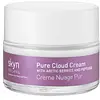What's inside
What's inside
 Key Ingredients
Key Ingredients

 Benefits
Benefits

 Concerns
Concerns

No concerns
 Ingredients Side-by-side
Ingredients Side-by-side

Water
Skin ConditioningNiacinamide
SmoothingPropanediol
SolventGlycerin
HumectantTriolein
Skin ConditioningEthyl Olivate
EmollientHydroxyethyl Acrylate/Sodium Acryloyldimethyl Taurate Copolymer
Emulsion StabilisingAstrocaryum Murumuru Seed Butter
EmollientPassiflora Edulis Seed Oil
EmollientPhenoxyethanol
PreservativeSodium Gluconate
Skin ConditioningMadecassoside
AntioxidantCitric Acid
BufferingEthylhexylglycerin
Skin ConditioningSorbitan Isostearate
EmulsifyingOlea Europaea Leaf Extract
PerfumingTocopherol
AntioxidantWater, Niacinamide, Propanediol, Glycerin, Triolein, Ethyl Olivate, Hydroxyethyl Acrylate/Sodium Acryloyldimethyl Taurate Copolymer, Astrocaryum Murumuru Seed Butter, Passiflora Edulis Seed Oil, Phenoxyethanol, Sodium Gluconate, Madecassoside, Citric Acid, Ethylhexylglycerin, Sorbitan Isostearate, Olea Europaea Leaf Extract, Tocopherol
Water
Skin ConditioningHydrogenated Didecene
Skin ConditioningButylene Glycol
HumectantGlyceryl Stearate
EmollientBisabolol
MaskingPrunus Amygdalus Dulcis Oil
Skin ConditioningSodium Hyaluronate
HumectantHydrolyzed Rice Protein
Skin ConditioningAngelica Archangelica Root Water
Skin ConditioningAcetyl Dipeptide-1 Cetyl Ester
Skin ConditioningLeuconostoc/Radish Root Ferment Filtrate
AntimicrobialCamellia Oleifera Leaf Extract
AstringentGlycerin
HumectantGlyceryl Caprylate
EmollientRubus Chamaemorus Seed Oil
Skin ConditioningSimmondsia Chinensis Seed Oil
EmollientAcrylates/C10-30 Alkyl Acrylate Crosspolymer
Emulsion StabilisingCanola Oil
EmollientCetyl Alcohol
EmollientCetyl Ricinoleate
EmollientSorbitan Stearate
EmulsifyingStearic Acid
CleansingCitrus Grandis Peel Oil
MaskingTriceteareth-4 Phosphate
EmulsifyingSilica
AbrasiveZea Mays Starch
AbsorbentGlyceryl Undecylenate
EmollientLaureth-3
EmulsifyingSodium Hydroxide
BufferingAloe Barbadensis Leaf Juice
Skin ConditioningHydroxyethylcellulose
Emulsion StabilisingPerfluorodecalin
Skin ConditioningPotassium Sorbate
PreservativeSodium Polyacrylate
AbsorbentEthylhexyl Stearate
EmollientSodium Benzoate
MaskingBuddleja Davidii Extract
Skin ConditioningGlycosphingolipids
EmollientSucrose Palmitate
EmollientThymus Vulgaris Flower/Leaf Extract
MaskingTrideceth-6
EmulsifyingXanthan Gum
EmulsifyingBiotin
AntiseborrhoeicWater, Hydrogenated Didecene, Butylene Glycol, Glyceryl Stearate, Bisabolol, Prunus Amygdalus Dulcis Oil, Sodium Hyaluronate, Hydrolyzed Rice Protein, Angelica Archangelica Root Water, Acetyl Dipeptide-1 Cetyl Ester, Leuconostoc/Radish Root Ferment Filtrate, Camellia Oleifera Leaf Extract, Glycerin, Glyceryl Caprylate, Rubus Chamaemorus Seed Oil, Simmondsia Chinensis Seed Oil, Acrylates/C10-30 Alkyl Acrylate Crosspolymer, Canola Oil, Cetyl Alcohol, Cetyl Ricinoleate, Sorbitan Stearate, Stearic Acid, Citrus Grandis Peel Oil, Triceteareth-4 Phosphate, Silica, Zea Mays Starch, Glyceryl Undecylenate, Laureth-3, Sodium Hydroxide, Aloe Barbadensis Leaf Juice, Hydroxyethylcellulose, Perfluorodecalin, Potassium Sorbate, Sodium Polyacrylate, Ethylhexyl Stearate, Sodium Benzoate, Buddleja Davidii Extract, Glycosphingolipids, Sucrose Palmitate, Thymus Vulgaris Flower/Leaf Extract, Trideceth-6, Xanthan Gum, Biotin
 Reviews
Reviews

Ingredients Explained
These ingredients are found in both products.
Ingredients higher up in an ingredient list are typically present in a larger amount.
Glycerin is already naturally found in your skin. It helps moisturize and protect your skin.
A study from 2016 found glycerin to be more effective as a humectant than AHAs and hyaluronic acid.
As a humectant, it helps the skin stay hydrated by pulling moisture to your skin. The low molecular weight of glycerin allows it to pull moisture into the deeper layers of your skin.
Hydrated skin improves your skin barrier; Your skin barrier helps protect against irritants and bacteria.
Glycerin has also been found to have antimicrobial and antiviral properties. Due to these properties, glycerin is often used in wound and burn treatments.
In cosmetics, glycerin is usually derived from plants such as soybean or palm. However, it can also be sourced from animals, such as tallow or animal fat.
This ingredient is organic, colorless, odorless, and non-toxic.
Glycerin is the name for this ingredient in American English. British English uses Glycerol/Glycerine.
Learn more about GlycerinWater. It's the most common cosmetic ingredient of all. You'll usually see it at the top of ingredient lists, meaning that it makes up the largest part of the product.
So why is it so popular? Water most often acts as a solvent - this means that it helps dissolve other ingredients into the formulation.
You'll also recognize water as that liquid we all need to stay alive. If you see this, drink a glass of water. Stay hydrated!
Learn more about Water